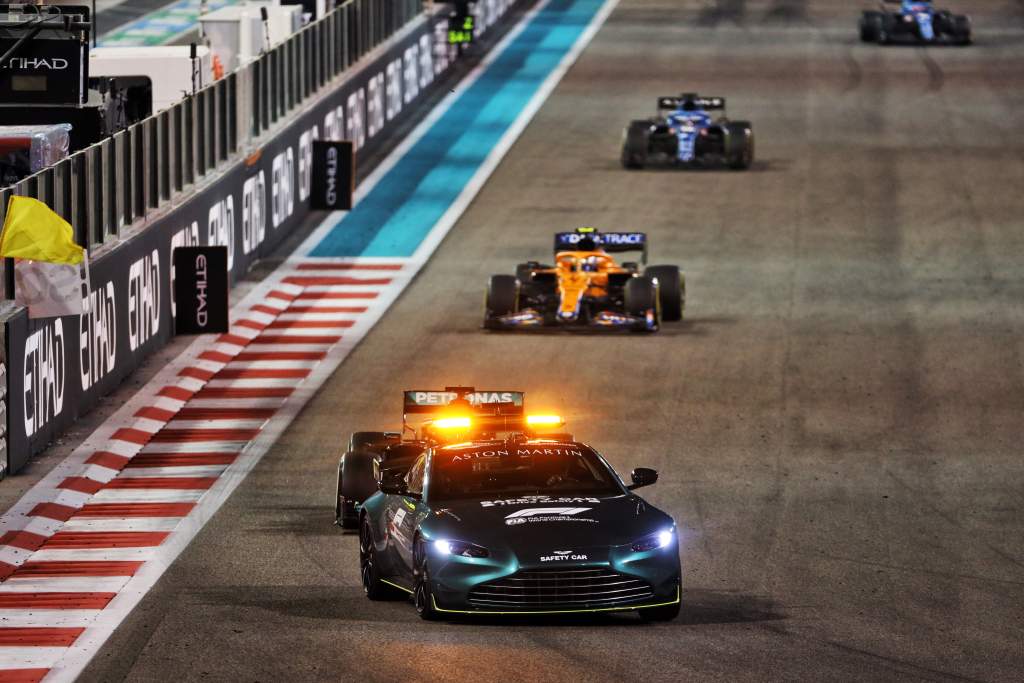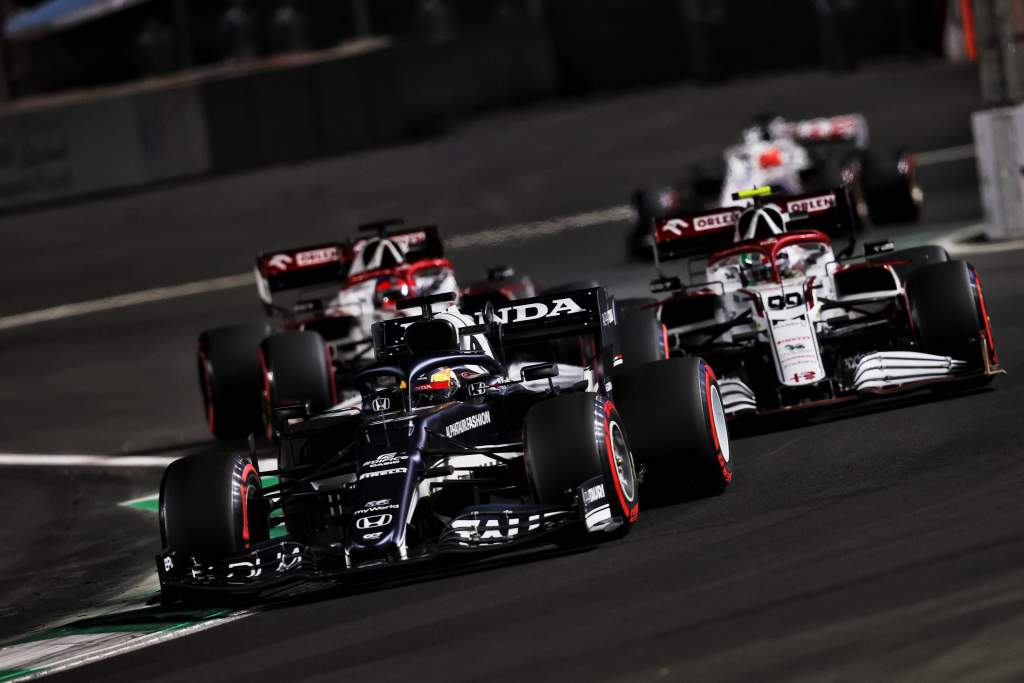Up Next

Officiating is front and centre every year when it comes to Formula 1, but in 2021 it felt, at least anecdotally, like there was an above-average number of grievances and disagreements when it came to the rulebook and the way its tenets were implemented.
And while F1 has already tweaked certain things, there’s still a lot to work on – with the controversial Abu Dhabi finale potentially providing an impetus to revamp things sooner rather than later.
Informed by events in 2021, here’s what our F1 writers think can be done to shore up the rulebook and in-race governance.
SAFETY CAR RESTART PROCEDURE
The flashpoint
The restart at the start of the final lap of the title-deciding Abu Dhabi Grand Prix proved hugely controversial given Max Verstappen went on to overtake Lewis Hamilton and take the world championship.
Mercedes protested but did not proceed with an appeal, on the basis that the restart procedure was incorrect. This related to only five of the eight lapped cars being allowed past the safety car, and the timing of the restart.
What the rules say now
The first of two sporting regulations that Mercedes protested were 48.12, which states “any cars that have been lapped by the leader will be required to pass the cars on the lead lap and the safety car” and that “once the last lapped car has passed the leader the safety car will return to the pits at the end of the following lap”.
The Mercedes complaint was that not all the lapped cars were allowed past (although it should be noted that the meaning of “any” in the regulation is not identical to “all”, meaning there is scope for this to be argued), and that the race could not have restarted at the end of lap 57 given the lapped cars were only given the instruction to go past on the same lap.
While the FIA argued that the restart procedure in Article 48.13 overrides this, the timing of the restart was in direct contravention of what the sporting regulations state.
What we think the rule needs to be
The rules must be clarified to ensure that there is no confusion about whether all lapped cars have to be let past the safety car or if the race director has discretion on how many are let past.
As for the timing of the restart, if the FIA wants the scope to restart the race at the end of the same lap on which the lapped cars are sent past then the rule stating that the safety car returns to the pits at the end of the next lap should simply be deleted.
But it’s essential there is a wider investigation into the way the restart was handled to avoid future problems with the way race control handles races – something the FIA has promised and that Mercedes has vowed to hold it to account on.
TRACK LIMITS
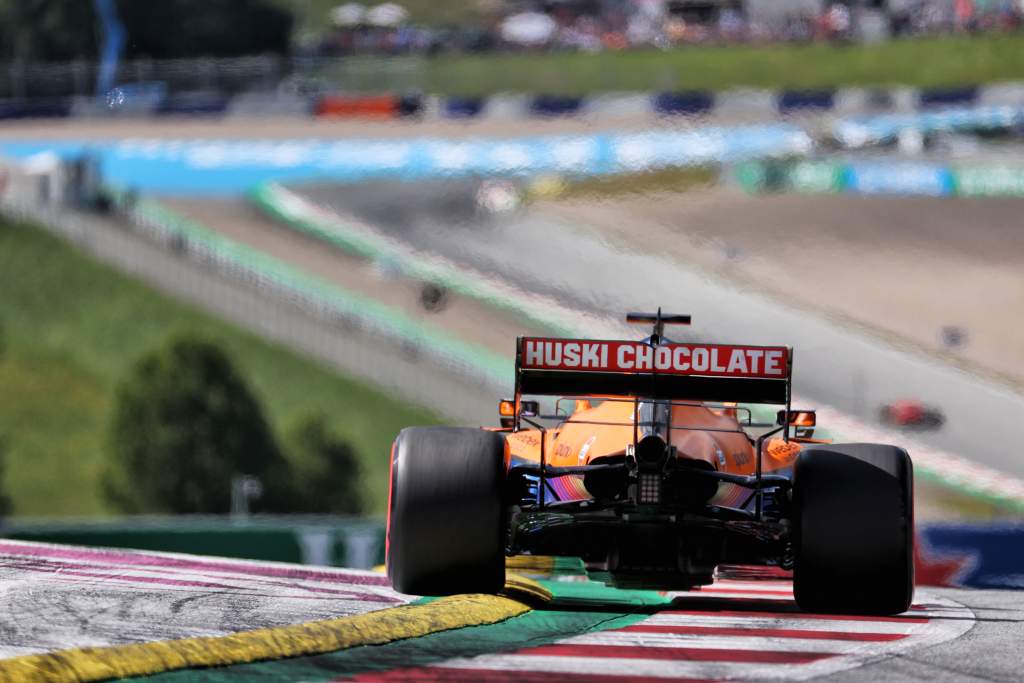
The flashpoint
Take your pick… but the first major track limits controversy feels like the most egregious: Bahrain, where the rules changed multiple times and even appeared to in the race itself, much to Verstappen’s annoyance.
What the rules say now
The key part of the regulations states that “drivers will be judged to have left the track if no part of the car remains in contact with it and, for the avoidance of doubt, any white lines defining the track edges are considered to be part of the track but the kerbs are not”.
What we think the rule needs to be
This definition is fine. The problem is that it is not always applied: sometimes a kerb is defined as the track edge, sometimes grass or gravel is. And sometimes it changes through the weekend.
The rule can stay but its application must be more consistent.
QUALIFYING QUEUES
The flashpoints
Several. But in Abu Dhabi, a farcical end to Q1 featured multiple cars travelling extremely slowly, causing several incidents of impeding that went unpunished – despite being near-identical offences to those that earned penalties earlier in the year.
What the rules say now
Penalties can be applied to “any driver taking part in any practice session [this includes qualifying] who stops unnecessarily on the circuit or unnecessarily impedes another driver” – plus, occasionally there are specific instructions from the race director.
What we think the rule needs to be
Applied consistently as it is, reinforced by a maximum time in each sector, not the lap as a whole, to stop the drivers cruising around the last corner. In Abu Dhabi, the stewards came up with various excuses: poor radio communication from teams, no “unnecessary impeding”, and the odd claim of drivers being a victim of a chain of cars backing up. These don’t normally save a driver from a penalty so clearly the stewards got more lenient and that makes policing this issue clear as mud.
THE IMOLA CASE
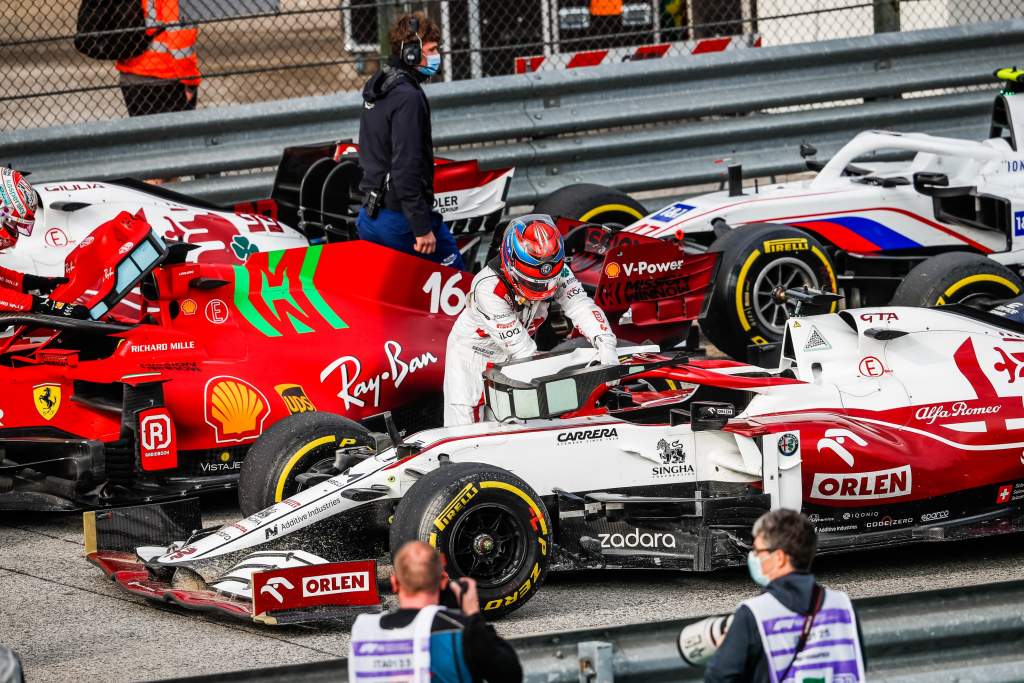
The flashpoint
After finishing ninth in the Emilia Romagna Grand Prix, his and the Alfa Romeo team’s first points finish of the season, Kimi Raikkonen was hit with a 25-second post-race penalty for taking the safety car restart after the red flag from the incorrect position.
Having spun into the gravel after being released from the pits to take his lap back, he restarted in 10th rather than eighth place. According to the rules, he should either have started in his correct position before reaching pit entry, or dived into the pitlane and taken the restart from there.
Alfa Romeo sought and was granted a review, but the penalty was not rescinded despite stewards accepting there was a “contradiction” in the regulations.
The confusion arose when the instruction was given for a rolling restart, rather than a standing restart, which Alfa Romeo believed meant overtaking was not allowed, preventing Raikkonen from regaining position.
What the rules say now
At the time, Article 42.6 of the sporting regulations stated a driver must either regain their original position by the time they reach the pit entry or take the start from the pits.
The contradictory rule was Article 42.12 that prevents overtaking under the safety car. As race control signalled a safety-car restart, rather than a standing restart, before Raikkonen had the chance to recover position, the Alfa Romeo team felt this took precedence and told their driver not to overtake.
What we think the rule needs to be
In July, modified sporting regulations were issued eliminating the potential for confusion in such situations as a direct result of what happened at Imola. These changes explicitly stated what was and was not permitted in restarts after a red flag.
But this is an example of how certain rule changes, in this case, the introduction of a second kind of post-red flag restart, can create unprecedented situations that cause confusion – stressing the need to evaluate rigorously what impact any future changes might have on other aspects of the regulations.
Who yields?
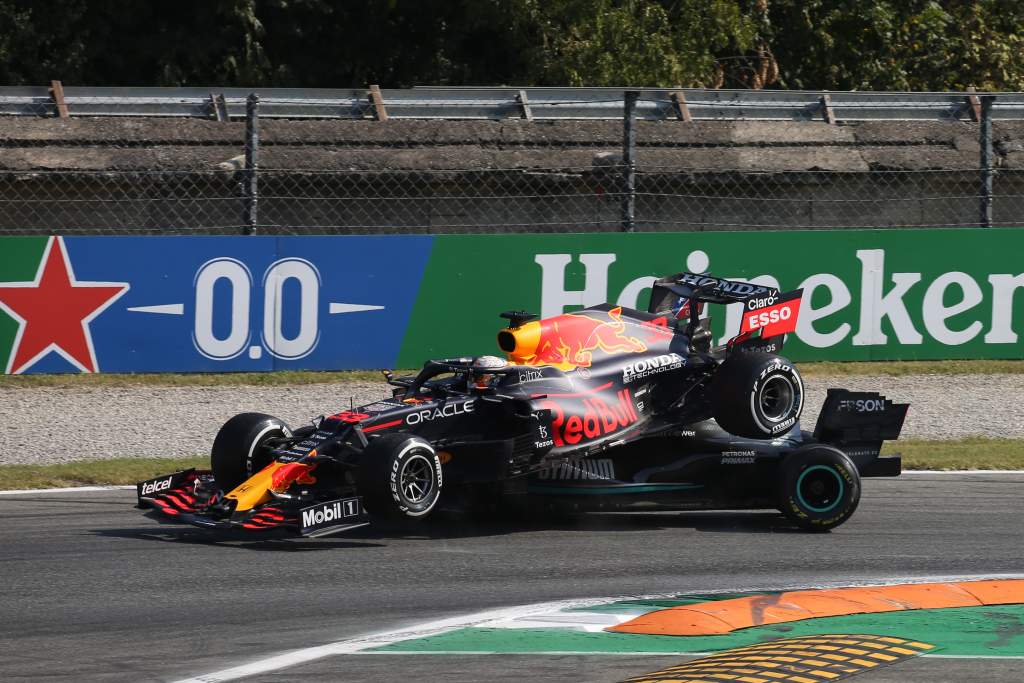
The flashpoints
The race-ending collisions between the two F1 title protagonists both qualify, but it was a recurring topic in their season-long battle even outside Silverstone and Monz.
What the rules say now
The rules are vague here, probably deliberately so. If two cars are alongside each other – partially or fully – on the corner approach, the leader must leave one car’s width on whichever side the other car is.
The leader cannot crowd the competing car into surrendering the place before the corner by running it out of race track. Once even partially alongside, the following car has a right to racing room.
Where it gets complicated is when they are early into the corner and alongside each other, partially or fully. There is an unofficial guideline provided to stewards only for direction, not as part of any regulation. This states that in such a situation it is ultimately the car on the outside which should yield even if the car on the inside is only partially alongside – i.e. even if the car on the outside is ahead.
So long as the inside driver has at least part of their car alongside, they have the right to the corner.
The stewards were not guided by this in their decisions at both Silverstone and Monza, however, where it was the inside driver who was penalised on each occasion (Hamilton at Silverstone, Verstappen at Monza).
What the rule should be
Retain the one car’s width on the approach requirement. That’s a good, clear and fair regulation and should be retained.
But once past that point in the corner, there should be no absolute stipulation that blame need be apportioned in any incident. The idea that there can be a no-blame accident should be embraced because this is racing and neither driver should be obliged to yield.
Advantage gained off-track
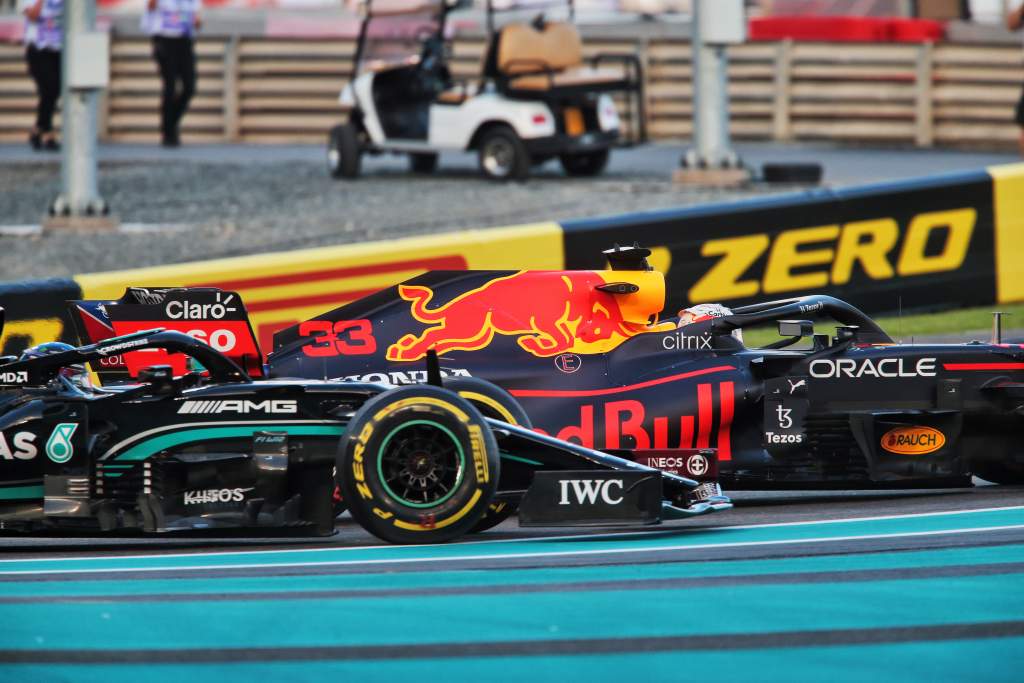
The flashpoints
Again, there have been multiple Hamilton/Verstappen cases to dig into here, but the one freshest in memory is the Abu Dhabi Turn 6 non-pass that for a good chunk of the race looked like it could prove decisive in the 2021 title battle.
What the rules say now
Any place made by going off track – either passing while off track or passing subsequently through the speed advantage gained by running off track – must be given back.
What we think the rule should be
In terms of the overtaking car, there’s nothing really wrong with the rule as it is. But there should probably be some attention given to avoiding being passed by running off track. If the inside driver forces the outside driver to yield only by leaving the track (i.e. Verstappen, Turn 4, Brazil) then the place must be handed back.
But if the inside driver is ahead and chooses to use up all the available track exit (i.e. Verstappen Turn 6, Abu Dhabi, lap one), forcing the outside driver to leave the track to avoid a collision, that should be a legitimate move. It’s up to the outside driver to judge whether they wish to hang on and try to make the other yield, but if there is contact it will not be deemed the inside driver’s fault.
Giving back the position at a part of the track which disadvantages the overtaking driver (for example, just before the DRS detection point) should specifically be banned.



